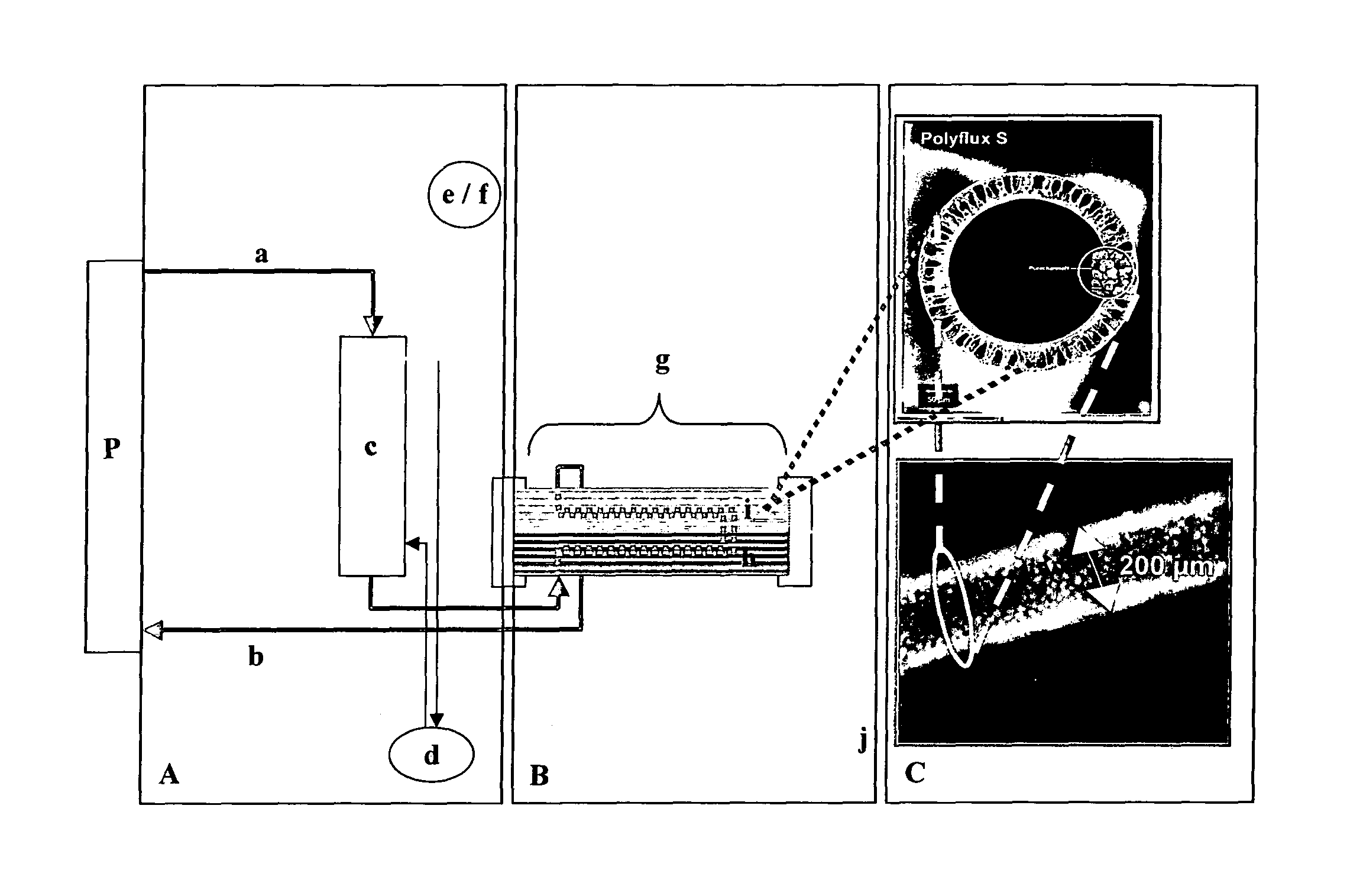Hybrid bioartificial kidney
a bioartificial kidney and hybrid technology, applied in the field of bioartificial kidney equivalent, can solve the problems of not completing renal replacement therapy, patients with end-stage renal disease on dialysis continue to have major medical, social and economic problems, and the risk of death is 5 to 8fold
- Summary
- Abstract
- Description
- Claims
- Application Information
AI Technical Summary
Benefits of technology
Problems solved by technology
Method used
Image
Examples
example 1
Preparation of Hollow Fiber Membranes
[0131]A polymer solution was prepared by mixing 14.0 wt.-% of polyethersulfone (BASF Ultrason 6020), 5.0 wt.-% of PVP K30, 2.0 wt.-% of PVP K85 / K90, 3 wt.-% of water and 76.0% of NMP. A mixture of 55 wt.-% water and 45 wt.-% NMP served as center fluid. The viscosity of the polymer solution, measured at a temperature of 22° C., was 5,400 mPa·s.
[0132]The center fluid was heated to 55° C. and pumped through a two-component hollow fiber spinneret. The polymer solution was leaving the spinneret through an annular slit with an outer diameter of 0.5 mm and an inner diameter of 0.35 mm. The center fluid was leaving the spinneret in the center of the annular polymer solution tube in order to start the precipitation of the polymer solution from the inside and to determine the inner diameter of the hollow fiber. At the same time, the two components (polymer solution and center fluid) were entering a space separated from the room atmosphere. The space is cal...
example 2
Preparation of Filters
[0133]Filters (hollow fibers in a housing) which were subjected to gamma-ray irradiation comprised the hollow fiber membranes of Example 1. The materials for housing, headers, and potting were gamma stable and consisted of Makrolon® DP1-1262 with Fibasol blue (housing / headers) and gamma-stable polyurethane (potting). Filters containing PES / PVP-based membranes (see Example 1) were filled with ambient air and subjected to gamma irradiation from a Co-60 source for 18.9 hours at room temperature, applying a dose of 75 kGy.
example 3
Preparation of Filters Lined with Adherent Renal Cells
[0134]Filters modules prepared according to Example 2 were seeded with human proximal renal tubule epithelial cells (hPTEC) and human distal renal tubule epithelial cells (hDTEC), respectively.
[0135]For this purpose, the extracapillary compartment (EC) of the module was washed three times with saline, then filled with saline and sealed. Subsequently, the intracapillary compartment (IC) was flushed with saline. A suspension of cells in PBS having a concentration of 0.5-1.0 Mio cells / ml was prepared and slowly fed to the IC of the module through one of the inlets, while liquid was withdrawn from the EC through one of the outlets. After the total volume of the suspension had been fed to the module, the inlets / outlets of the IC were sealed and perfusion of the culture medium through the EC was started. After 12 hours of perfusion, the IC was rinsed with culture medium for 10 minutes to remove non-adhered cells and then the inlets / out...
PUM
| Property | Measurement | Unit |
|---|---|---|
| molecular weight | aaaaa | aaaaa |
| molecular weight | aaaaa | aaaaa |
| molecular weights | aaaaa | aaaaa |
Abstract
Description
Claims
Application Information
 Login to View More
Login to View More - R&D
- Intellectual Property
- Life Sciences
- Materials
- Tech Scout
- Unparalleled Data Quality
- Higher Quality Content
- 60% Fewer Hallucinations
Browse by: Latest US Patents, China's latest patents, Technical Efficacy Thesaurus, Application Domain, Technology Topic, Popular Technical Reports.
© 2025 PatSnap. All rights reserved.Legal|Privacy policy|Modern Slavery Act Transparency Statement|Sitemap|About US| Contact US: help@patsnap.com



